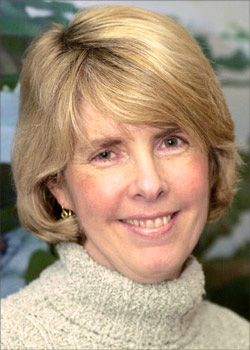 I found the following article at “The Daily Gazette” about Jamison’s seminar on “Madness, Moods, and Creative Achievement” at the Science Center 101 back in 2005. It serves as a good summary of her discussion at Johns Hopkins’s Mood Disorders Symposium, as well. To get to the original article, click here.
I found the following article at “The Daily Gazette” about Jamison’s seminar on “Madness, Moods, and Creative Achievement” at the Science Center 101 back in 2005. It serves as a good summary of her discussion at Johns Hopkins’s Mood Disorders Symposium, as well. To get to the original article, click here.
Science Center 101 was packed with students and faculty on Thursday afternoon to listen to noted researcher Kay Redfield Jamison speak on “Madness, Moods, and Creative Achievement.” Jamison is a Professor of Psychiatry at Johns Hopkins and the co-director of the Mood Disorders Center at the Hopkins School of Medicine, but she is best known for her writings. She revealed her own struggle with manic depression in her 1995 memoir “An Unquiet Mind,” a bestseller that is now being turned into a movie.
The topic of Thursday’s lecture came from Jamison’s book “Touched with Fire: Manic-Depressive Illness and the Artistic Temperament,” and explored the relationship between madness and imagination that has been noted since pre-Grecian times. It is a difficult topic, began Jamison, because while these are “devastating illnesses that you don’t want to romanticize, you also don’t want not to study a potential link with so many intellectual and clinical implications.”
Jamison spoke at length about the techniques used to make “post mortem diagnoses” of disturbed artistic and literary geniuses. Bipolar and manic-depressive individuals generally have their first episode in adolescence or their early twenties; both are cyclic disorders for which interepisode functioning is normal, but the episodes will become progressively more relentless unless treated. An average manic episode lasts from one to three months, and untreated bipolar episodes generally run from nine months to a year.
Researchers can look at the productivity patterns of writers and artists for clues about their mental health. A fairly continuous pattern may suggest mental stability, whereas those with mood disorders tend to display disruptive and erratic patterns. As an example, Jamison suggested the German composer Schumann, whose hypomanic years were his most productive and who spent the last years of his life in a depressive and unproductive period.
Jamison also spent some time on interesting correlations between mental instability and the time of year. Manic episodes generally appear in late summer and early fall, and depressive episodes in the spring and late fall. In a reversal of conventional wisdom, May and June are the most common months for suicide.
Since bipolar disorder and manic-depressive illness are both linked strongly to genetics, another good way to trace them are through assembling family pedigrees. Many of us know that Ernest Hemingway committed suicide, but who would have guessed that so did his brother, his sister, his father, and one of his grandchildren?
While only 1% of the general population will ever commit suicide, Jamison presented the sobering statistic that according to some studies, up to 18% of poets will.
She ran through many different statistics showing a clear correlation between mental illness and creativity before turning to the question of what it all meant. Is there correlation but not causation? Are depressed people more drawn to creative careers? Does creative work cause mood disorders? Or, as Jamison believes, can mood disorders facilitate even greater creativity in individuals who are already creative?
Mania causes acute changes in mood and thinking and long-term changes in observing and reflecting on one’s environment; it is associated with expansive, original, and over-inclusive thought; elevated mood has a profound effect on word association. “If this relationship exists,” asked Jamison, “is there a risk of losing it if you treat somebody? Artists and writers are legitimately concerned about these things.”
Jamison personally believes that clinicians have an obligation to be informed about the diseases they treat, and to recognize the importance of medication even if the individual rejects it. Some individuals can become addicted to mania-“as a drug, hypomania leaves cocaine in the dust”-romanticizing their illness and attempting to recapture their highs by any means possible.
But the risks of refusing medication are higher than any creative loss that may occur, stressed Jamison, who pointed to a statistic showing that patients on lithium are nine times less likely to commit suicide. In fact, even the loss of one’s creativity should not be a great worry; two-thirds of patients report no change in intellectual ability and three-fourths no decline in productivity.
Jamison ended her talk on a hopeful note, telling the audience that today’s treatments offer great hope for bipolar and manic-depressive individuals to triumph over their illness, and she is a living example.
* Click here to subscribe to Beyond Blue and click here to follow Therese on Twitter and click here to join Group Beyond Blue, a depression support group. Now stop clicking.

